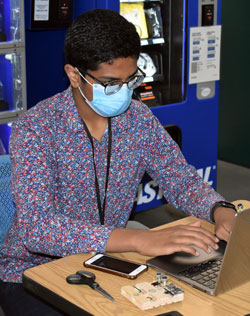Grand Rapids – A frustrating experience trying to find parking ahead of a Grand Rapids Griffins hockey game set a City High junior down a path that may someday benefit others in a similar spot.
Vishnu Mano has been working for close to a year on what began simply as a school project, then morphed into an internship with the city through the Grow 1000 program and now, even after the internship has ended, remains a passion project Vishnu plans to continue to pursue in 2021-22.
The project is called Spotter, and it uses a microcontroller, ultrasonic sensors and code from two programming languages to help drivers quickly find an open parking spot in crowded cities.
His efforts are in the trial phase in a parking ramp at 50 Ottawa NW in Grand Rapids, and he hopes that someday what he’s working on might be an option for parking spot seekers across the city.
The basic set-up is pretty simple. Two sensors are mounted on a small platform and connected to a microcontroller and a power supply. One sensor sends a wave out and if it hits a car, the wave returns to a second sensor which tells the chip to register the parking spot as taken in the accompanying app with a red X. If the wave doesn’t return to the second sensor, then the parking spot is marked as available in green in the app.
The parts are cheap when purchased in bulk. The whole system can be put together for under $2, Vishnu said.
The reason it works is a whole lot of coding by Vishnu, the gregarious son of two Indian immigrants, who said he began to take an interest in computers and what makes them run already in fourth grade.

Operating in Real-World Conditions
Already he has made major refinements to the system from when he first began in terms of both its size and accuracy. He has a few other tweaks in mind going forward, including looking at having each unit self-powered (currently they are plugged in). He’s had two units in 50 Ottawa NW for about two months now and is using the in-the-field experience to figure out what’s working well and what needs improvement.
“One thing we discovered is that with curved surfaces the wave could bounce up and not return, and then the spot would seem empty, but it wasn’t,” he recalled. “So, we fixed that with a bit of code.”
A bit of code, in this case, is a bit of an understatement. Along with other programming languages, Vishnu is using a coding language often used for smart appliances such as fridges and dishwashers.
“My favorite part of programming,” he said, “is the potential it gives you to impact your community in a positive way. Doing something real-world is definitely motivating.”
Vishnu’s passions are many. He’s also a violinist with the Grand Rapids Youth Symphony and a state-champion debate team member, and he has a YouTube channel where he posts violin covers of classical Indian songs and tutorials on programming languages.
Open Source Code Could Lead to Further Improvements
He’s already working on a next iteration of the system that will attempt to include new elements of the latest Apple operating system, specifically the code behind the Find My iPhone feature that now points people to their phone with visual cues.
“That code is now open source,” he said with an excited smile. “I’m going to try to implement that.”
Colin Cooper, one of his internship supervisors, said don’t bet against him.
An information systems coordinator for Grand Rapids, Cooper oversees the selection, implementation and maintenance of department-level technologies, and he recalled how impressed he was when Vishnu reached out to his department by email in early 2021.
“After a Zoom meeting we knew he would be a great candidate for our internship program,” Cooper recalled. “He was professional and organized, and we were excited to facilitate the opportunity for him to build out his idea. Working with Vishnu has been a great experience. His determination, attention to detail and tech-savvy serve him well, and I’m excited to see where these qualities take him in school and beyond.”









